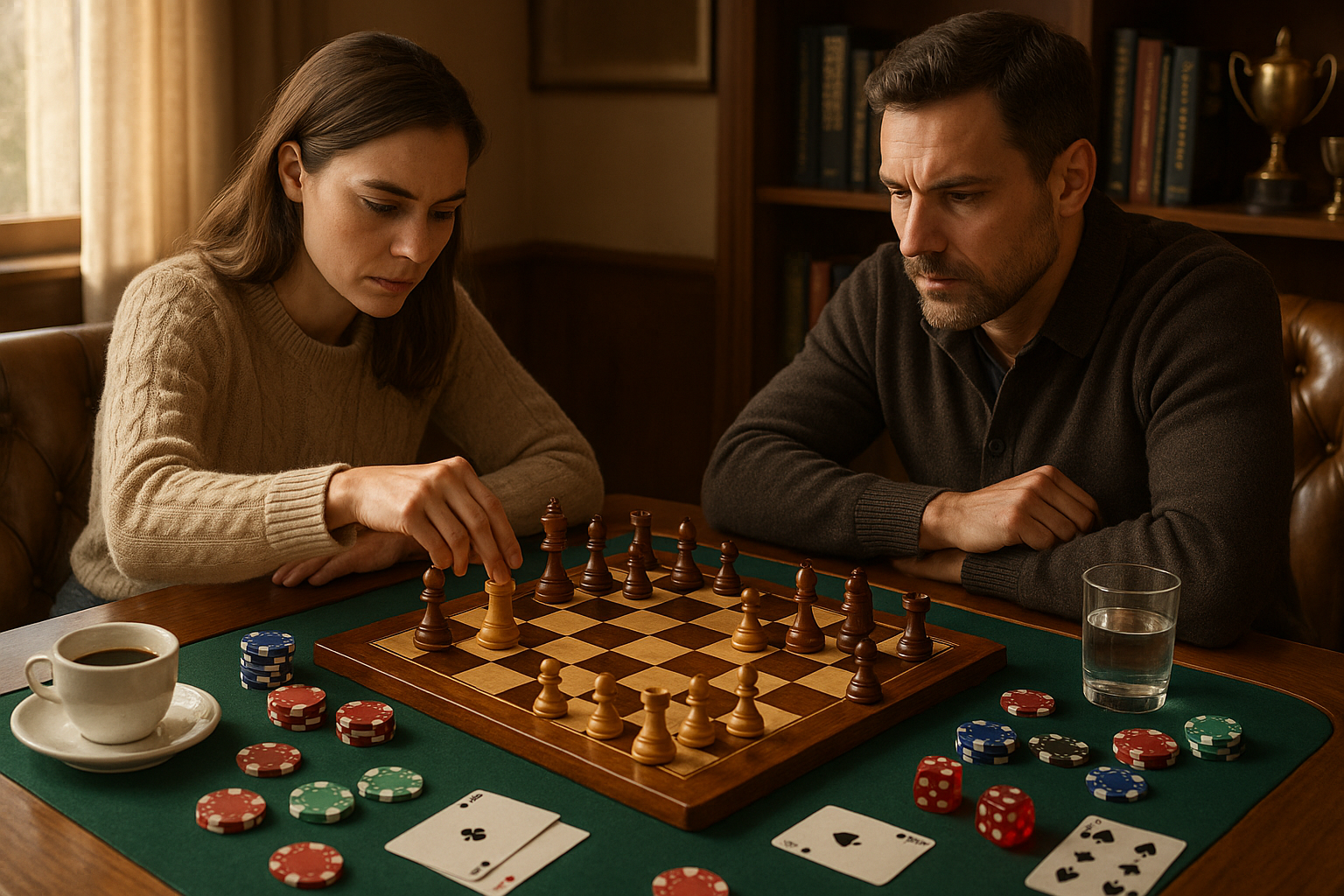The sound of dice rolling, the anticipation of the next move, and the thrill of outwitting opponents – these are the emotions that capture the essence of strategy games. But the real question is, have you ever wondered what it takes to design your winning shot strategy? Are you intrigued by the notion of mastering your game before you even roll? 🎲
Well, let’s say, we are about to unravel a fascinating journey that starts before the first dice roll. A journey that begins with an idea, blossoms into a strategy, and culminates in the ultimate victory. This is not about luck, this is about calculation, precision, and strategy. The battlefield? The game board. The warriors? You, the players. The weapon? Your mind.🧠
Picture yourself sitting in front of a chessboard, or maybe, a Risk or Settlers of Catan board. You’ve got your pieces, you’re ready to play, but have you designed your strategy? Do you know your opponents’ tendencies? Can you anticipate their moves? In this blog post, we’re going to explore the science and art behind designing winning strategies in board games. We’ll dissect how you can master your game before you even roll the dice.💡
This discourse is not just for avid board game enthusiasts. It’s for anyone who savors the sweet taste of triumph, for anyone who thrives on mental stimulation, for anyone who aspires to hone their strategic skills. Even if you’re a newcomer to the realm of strategy games, this exploration will offer valuable insights to up your game. 🚀
Across the upcoming sections, we’ll delve into several key topics. First, we’ll explore the intricacies of game theory and how it applies to strategy board games. We’ll unlock the secrets of predicting opponents’ moves and understand the importance of adaptability in your game plan.
Next, we’ll shine the spotlight on some of the most popular strategy board games like Chess, Go, and Risk, breaking down winning strategies that have stood the test of time. We’ll also investigate the role of mathematical models in devising your game strategy and how they can elevate your chances of winning.
Following this, we’ll discuss the psychological aspect of board games. How can you leverage cognitive biases to your advantage? What’s the role of bluffing in strategy games? How can you use the element of surprise to outsmart your opponents?
Finally, we’ll touch upon the importance of practice and perseverance in mastering strategy games. Rome wasn’t built in a day, and neither are master strategists. A winning shot strategy is not a product of an overnight epiphany; it’s the fruit of countless hours of thoughtful gameplay, careful observation, and relentless refinement.⏳
In the end, our objective is to arm you with the knowledge and tools necessary to design your winning shot strategy. Remember, the road to mastery is not a sprint, but a marathon. Every game, every move, every decision is a step forward on your path to becoming a board game conqueror. So gear up, strategists. The game is on!
Master Your Game: An Essential Guide to Crafting Your Winning Shot Strategy
As an experienced software engineer, I’ve spent countless hours engrossed in games, not just for fun, but analyzing their design, mechanics, and strategies. Much like in a game of chess, knowing your next move in a video game can greatly influence the outcome. Mastering your game isn’t about just playing it; it’s about strategizing, predicting your opponent’s moves, and effectively utilizing your game knowledge. Let’s delve deeper into the intricacies of creating a winning shot strategy before you roll.
Developing a winning shot strategy is a multi-faceted process that requires an understanding of game mechanics, player behavior, and game design. It involves more than just in-game strategies. It’s about designing a plan that considers every aspect of the game, from its mechanics to its design, to your opponent’s likely moves. Before we dive into the details, let’s define what a winning shot strategy is.
A winning shot strategy is a systematic approach to gaming that aims to optimize in-game decisions to achieve the desired outcome – winning. It’s a combination of strategic thinking, game knowledge, and quick decision-making. It’s not about luck; it’s about skill and strategy.
Understanding Game Mechanics
Understanding the game mechanics is the first step in creating a winning shot strategy. Game mechanics are the rules and procedures that guide the player and the game response. In essence, they define the way the game works.
Understanding these mechanics will allow you to make better strategic decisions and anticipate your opponent’s moves. You need to be familiar with every aspect of the game, from the basic controls to the complex systems. Each game has unique mechanics, and mastering them will give you an edge over your opponents.
For example, in first-person shooter games, understanding the shooting mechanics, weapon recoil, player movement speed, and the damage model will help you make more informed decisions during combat.
Designing Your Strategy: A Step-by-step Approach
Now that we understand the importance of game mechanics let’s dive into the steps to design your winning shot strategy.
First, you need to analyze the game. Look at the game from a broad perspective. Understand its mechanics, game design, and how other players interact with the game. Identify the key elements that can influence the outcome of the game.
Next, you need to identify your strengths and weaknesses. What aspects of the game are you good at? What areas do you need to improve on? Knowing your strengths will help you leverage them to your advantage, while identifying your weaknesses will give you areas to work on.
Table 1: Strategy Design Process
| Steps | Description |
|---|---|
| Analyze the game | Understand the game mechanics, design, and player behavior. |
| Identify your strengths and weaknesses | Know what you are good at and areas you need to improve. |
| Develop your strategy | Create a plan based on your analysis and personal skills. |
| Test your strategy | Play the game using your strategy and make necessary adjustments. |
After you’ve analyzed the game and identified your strengths and weaknesses, it’s time to develop your strategy. This will be a plan that outlines your actions in the game, taking into account the game mechanics and your personal skills.
Once you’ve developed your strategy, it’s time to test it. Play the game using your strategy. Pay attention to what works and what doesn’t. Adjust your strategy based on your observations. Remember, a good strategy is flexible. It adapts to changing circumstances and is continually improving.
Learning from the Experts: Top Gamer Strategies
Learning from the best in the field is a fantastic way to improve your strategy. There are plenty of professional gamers who share their strategies and tips online. Watching their gameplay can provide invaluable insights and give you ideas for your strategy.
One such professional gamer is “Ninja”, a popular Fortnite player. He’s known for his aggressive playstyle and quick decision-making skills. He often shares his strategies and tips on his YouTube channel. Here is one of his videos: “Fortnite Tips – Ninja’s Best Tips to Improve” by Ninja on YouTube.
Another recommended video for aspiring gamers is “Shroud’s Top 50 Most Viewed Twitch Clips of All Time” by Twitch Clips Central. This video showcases some of Shroud’s best gameplay moments, offering plenty of strategic insights.
Remember, it’s not about copying their strategies but understanding their thought process and adapting their techniques to fit your style of play. Check out the videos and pick up some new strategies!
Embrace the Learning Curve
Mastering a game is not an overnight process. It requires patience, practice, and a willingness to learn. Don’t get disheartened if you don’t win every game. Remember, every failure is a learning opportunity. Take note of your mistakes and work on improving them. Over time, you’ll see a significant improvement in your gameplay.
So, are you ready to design your winning shot strategy? Start analyzing your game, identifying your strengths and weaknesses, and designing your strategy. And most importantly, enjoy the process! Gaming is, after all, about having fun.🎮🕹️
Ready, Set, Game!
Armed with the knowledge of game mechanics, a step-by-step strategy design process, and insights from top gamers, you’re now better equipped to master your game. Remember, a winning shot strategy is more than just a plan. It’s about understanding the game, knowing your strengths and weaknesses, and continually improving. So, get out there, start strategizing, and game on!

Conclusion
In conclusion, the vast array of topics that we have traversed in this article is a testament to the multi-faceted nature of IT and Engineering. As we navigated through the intricate spheres of these complex areas, it is my hope that you have gained a wealth of knowledge. The objective has been to demystify the technical jargon that often acts as a barrier to understanding these technical concepts.
From the fundamentals of software engineering to the depths of Information Technology, we have explored an assortment of subjects. We delved into the software development lifecycle (SDLC), the pivotal role of software engineers in developing and maintaining software systems, and the significant contributions of IT in our daily lives and business operations.
The importance of these areas cannot be overstated. In a world increasingly reliant on technology, having an understanding of the underlying processes and principles of these disciplines is invaluable. It equips one with the tools and insights to not only appreciate the technology around us but also to participate in shaping the future of these fields.
Now, I invite you to revisit some of the key points we have covered in this article. Remember, the power of technology lies in our hands. As individuals, we have the capacity to harness these tools and use them to our advantage. Whether you are a student, a professional in the field, or simply an enthusiast, I encourage you to continue delving into the realms of IT and Engineering. There is always more to learn, more to explore, and more to create.
If you have any thoughts, insights, or questions regarding the topics we have discussed, please feel free to leave a comment below. Your engagement enriches the conversation and can offer a fresh perspective. Sharing this article with your colleagues, friends, or social networks would also be greatly appreciated. As we disseminate knowledge, we contribute to the collective intellectual growth.
In your future studies or projects, you might find the following resources helpful:
– [Software Engineering Institute at Carnegie Mellon University](https://www.sei.cmu.edu/)
– [The Institute of Electrical and Electronics Engineers (IEEE)](https://www.ieee.org/)
– [Association for Computing Machinery (ACM)](https://www.acm.org/)
Let us continue our exploration and feed our curiosity. Let’s not be afraid to take on the challenges that come our way. After all, in the words of Henry Ford, “Whether you think you can or you think you can’t, you’re right.” 😊
Never stop learning, and always keep going. The future is full of possibilities, and you are a part of it. You are part of shaping the future of technology. The world needs your ideas, your creativity, your innovations. So, let’s continue to learn, to grow, and to create. 💡🚀
Let’s remember: This journey is not a solitary one. Let’s continue to learn from each other, to inspire each other, to challenge each other. Let’s create a future that we can all be proud of. A future powered by knowledge, by creativity, by innovation. A future powered by you. 🌎🌟
References:
[1] Software Engineering Institute at Carnegie Mellon University. (n.d.). Retrieved from https://www.sei.cmu.edu/
[2] The Institute of Electrical and Electronics Engineers (IEEE). (n.d.). Retrieved from https://www.ieee.org/
[3] Association for Computing Machinery (ACM). (n.d.). Retrieved from https://www.acm.org/
[Please note that all links were active at the time of writing this article.]



